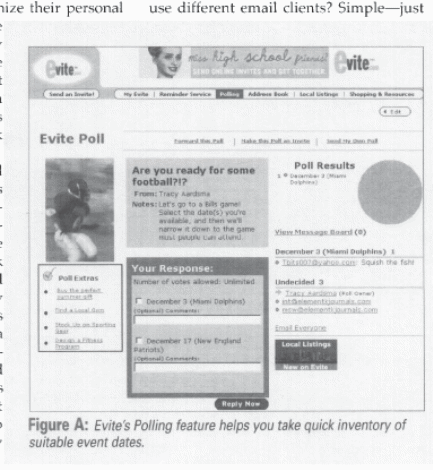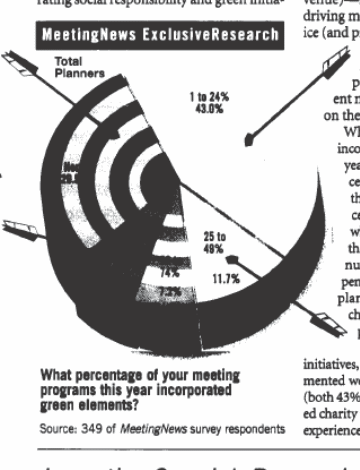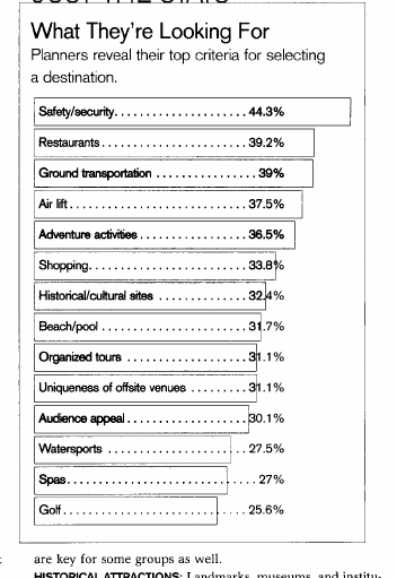Introduction
Despite the uncertainty and downright turmoil that impacts many industries in North America, the principal Euro Market economies, Japan, India, China and Singapore today, organizers report a stable core of events. Since market realities dictate increased competition for a temporarily-shrunken pool of event dollars, planners must work harder than ever to get business and raise their profile above those of rival alternatives and destinations.
As we shall see in the following pages, the industry is more responsive than ever in paying heed to social realities, creating differentiation, and leveraging technology for what has become an increasingly savvy and exacting audience of decision-makers and attendees.
Discussion
Technology advances
Much has been said about how the great advances in wireless networks, the Internet, mobile communications and video conferencing have shrunk the globe and made virtual “face-to-face” interaction possible even on a daily basis (see for example, Ball, 2007). This is all true and made even more pronounced by utilities as diverse as Google “Groups” and “Document Reviews”, Lotus Notes, Microsoft “HyperOffice” and “SharePoint”, WebMeeting, and Yahoo “Zimbra” for educational use. Doubtless, these have reduced the need for corporate travel notably when historic highs in jet fuel prices are reached, as happened in the Spring and Summer of 2008. And the best of “Web 2.0” technologies is yet to come, if O’Reilly (2005) and others are to be believed.
In fact, a study jointly undertaken by Meeting Professionals International (MPI) and American Express that surveyed over 1,000 meeting and event planners worldwide affirmed the expectation that virtual meetings will become even more popular but cannot possibly displace face-to-face meetings entirely (Meeting Professionals International, 2008). Bruce Macmillan, President and CEO of MPI, observed that “(while) meeting and event professionals are embracing technology, its greater role is in enhancing events, not replacing them” (Meeting Professionals International, 2008, 1997). The study concluded that the more likely effect over the medium term is that technological advances could help planners create more impactful and stimulating events.
As the generational shift from post-war “Baby Boomers” to “Generation Y” gathers momentum, chances are that more and more Web 2.0 technologies will creep into the ways associations and families interact and, by extension, enrich the events that bring them together. Reiterating his hoary maxim that “there is no such thing as (having a) virtual beer (together),” Ball (2007, 39) plays down the claim that webcasts and virtual meetings could possibly displace live and in-person events. Rather, he convincingly argues, associations and events will become more dynamic for leveraging trends and technologies that emerged very recently, just since 2002 or 2003.
Reminiscent of dating sites, Facebook and other vibrant social networking sites, there now exist nearly two dozen computer programs that offer to automatically match up the mutual interests of sellers and buyers, exhibitors and potential customers. These replace the hoary practice, dating back 40 years now, of walking around the convention venue for one-to-one introductions and getting-to-know-you’s with the help of the ubiquitous name badge or neck tag. Only a tiny fraction of such contacts made ever turn into hot-prospect sales leads. Hence, an event planner that can boast computer-aided matchmaking will be a leg up on the competition for making lead generation more efficient. Name cards embedded with radio-frequency identification (RFID) chips that can be read wirelessly by strategically-placed scanners or even mobile phones are already technologically feasible and could soon make qualified lead search and match-up’s even more rapid.
Just over the horizon is full-fledged testing and widespread adoption of the APEX (Accepted Practice Exchange) standard, akin to the electronic data interchange standard that permitted bank ATM’s to read, accept and service cards of every other bank. Already in testing between one event planner and hotel, APEX will enable planners, associations, hotel chains and other suppliers to seamlessly read event specs and the participant roster, thus saving up to 50% of the time currently taken up by reading, re-entering and proofreading RFPs, meeting specs, attendee rooming lists, and contracts (Ball, 2007).

On the more intimate, family- or clan-level type of event, the need of event planners to seamlessly manage invite and RSVP lists has also been addressed by the Evite suite for quite a time now (It’s a party–who’s got the chips? 2000). Evite gives event planners the benefit of an online address book, complete with email and contact group capabilities. Every invitation sent out automatically records the name and contact details in the address book, which can be synchronized with Microsoft Outlook, PalmPilots and other PIMs and PDAs (personal digital assistant) that both planner and host might need to work offline.
Social responsibility and going green
An interview with an industry source (see Appendix A for detailed notes) also revealed that meeting planners give more than a token nod to social responsibility in consciously opting to make a difference for the environment when planning their meetings and events. As many businesses have discovered, going green by promoting energy efficiency, cleaning up effluents and in other ways reducing the “carbon footprint” of the firm makes good civic and business sense, even enhancing the bottom line in some instances.

Alderton (2009) substantiates this “green” trend by affirming that the greater number of event and meeting planners have already worked on such events or expecting to do so in the near future, a phenomenon propelled by growing consumer demand that consequently impels companies to opt for environment-conscious policies and procedures. The evidence he cites for this trend comprises the rising number of green certification programs, environmentally-friendly meeting tools, and fair labor commitments.
“Green meetings”, it is claimed, can help planners reduce costs, support community initiatives and, most importantly, forge a positive impact on the environment (McDermott-Levy, 2008). Event Emissary, an event planning company based in Washington DC, hosted its first eco-friendly event on January 17, 2009. Co-founder Jenna Mack stated that this is the “opportunity to bring the need for eco-event planning…(to) millions of visitors headed to Washington for President-Elect Obama’s swearing in ceremony…the impact on our environment will be substantial. Our goal is to…[tread] lightly on the earth.” (Event Emissary, 2008, 214).
More and more, meeting and event planners look to work with caterers who can provide menu items of demonstrably organic origins. Environment-consciousness also extends to opting for decorations and setups that can be composted, recycled, and in all other respects save energy. This way, adverse environmental impact can be minimized while affording event planners and their clients cost savings.
Facing a recession down
Even should the current recession merely foreshadow a severe and sustained depression of the kind that followed the 1929 stock market crash, it is likely illusory to claim that remote meeting facilities will substantially displace events. For one thing, trade shows pose a very strong alternative to mainstream media in the marketing and sales media mix even in contractionary times. There is just no substitute, it seems, for being able to handle product samples or (an even more vital consideration) size up current offerings of the competition.

Secondly, companies have long viewed conventions and business events not as expenses but as a form of incentive, a perquisite for key staff and sales stars. Not surprisingly, Lemann (2007) reports, indulgence and privilege are clear hallmarks of a trend towards holding events in spa-resorts, as almost every resort has become in this decade. It is just that leisure or business travelers, as well as meeting attendees, are so enamored of the spa lifestyle that they gravitate toward resorts offering spa services. As the chart alongside shows, spa facilities have crept into the top baker’s dozen of criteria for destination choice.
Thirdly, celebratory events are a permanent fixture of the social and corporate scene. The year-end party, the anniversary fete, weddings and other special moments constitute inescapable opportunities for event planners, notwithstanding that some prudent budget-trimming may be called for by the present business climate.
Conclusion
At the end of the day, this concededly brief paper shows, a survival strategy for the event planning industry in the teeth of the current economic hurricane includes hunting for business verticals that continue to do well, deploying technology advances both for operational efficiencies and creating multi-media spectacles that ensure memorable points of difference, and accommodating social movements and the social responsibility imperative by going green (while saving money). By co-opting vital social and technological trends, event planners bid fair to be leaner, fitter and even more competitive when the economic upturn eventually comes.
References
Anonymous (2008). Choosing a destination. Chapter 8: The Incentive Buyers Handbook/Successful Meetings; pp. 34-38.
Alderton, M. (2009, February). Sustainable meetings report debuts. Successful Meetings, 58(2), 16.
Ball, C. (2007). Trends that will transform your meetings. Associations Now; pp. 39-43.
Event Emissary; Inaugural Celebrations Will Have Environmental Impact. (2008). Ecology, Environment & Conservation,214.
Hardin, T. (2008). Green & social responsibility: The year that was in meetings. Meeting News, 32(19), 0_1, pp. 22,28.
It’s a party–who’s got the chips? (2000). Inside the Internet, 7(12), pp. 1-6.
Lemann, M. (2007). The designer spa. Successful Meetings,1 56(7), pp. 42,44-46,48.
McDermott-Levy, R. (2008). Green meetings: Hosting environmentally friendly events. The Journal of Continuing Education in Nursing, 39(9), 388-9.
Meeting Professionals International. (2008). Meeting Professionals International and American Express study forecasts solid 2008 for meeting industry. Journal of Technology & Science; 1997.
O’Reilly, T. (2005). What is Web 2.0. [Internet] O’Reilly Media. Web.